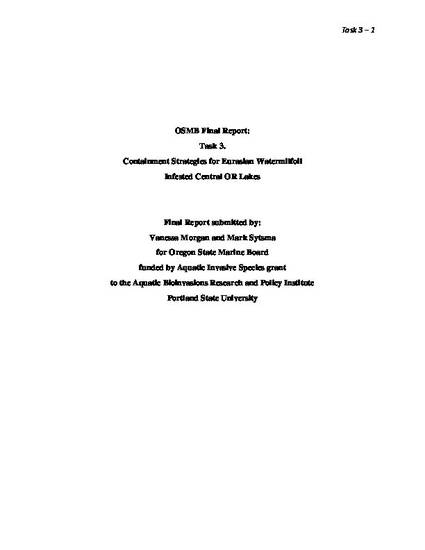
- Introduced aquatic organisms -- Control -- Oregon,
- Aquatic ecology -- Oregon,
- Eurasian watermilfoil
In recent years, public awareness of aquatic invasive species (AIS) has increased considerably in Oregon and elsewhere in the western U.S.. News articles, boat inspection stations and AIS permit programs have drawn attention to the threat of aquatic invasive species, especially animals like zebra mussels (Dreissena polymorpha), quagga mussels (Dreissena bugensis), and New Zealand mudsnails (Potamopyrgus antipodarum). However, invasive aquatic plants are also capable of causing severe impacts and may similarly be transferred between waterbodies on boats, trailers or other equipment. Heavy infestations can hinder recreational use by motorized and non-motorized boats, snag fishing lines, threaten the safety of swimmers and water-skiers, restrict delivery of irrigation water or quality of drinking water, and negatively impact aquatic habitats used by wildlife. One such plant, Eurasian watermilfoil (Myriophyllum spicatum), is wide-spread in much of the United States, but has only recently been found in four waterbodies in central Oregon’s Deschutes and Jefferson counties. This plant and many other macrophytes are capable of surviving when fragments or seed are carried to new waterbodies by natural or human-mediated means. While certain natural vectors like water currents and birds cannot be controlled, a containment strategy aimed at reducing secondary spread of EWM to new waterways via boat traffic would benefit aquatic resources in the region. Towards that goal, we examined boat launches at known infested waterbodies to determine: the extent of Eurasian watermilfoil, whether physical control techniques would reduce boaters’ direct encounters with this weed, and general awareness of AIS and support for local control of EWM by lake users.
Available at: http://works.bepress.com/mark_sytsma/15/

Final Report prepared for the Oregon State Marine Board, funded by Aquatic Invasive Species grant to the Aquatic Bioinvasions Research and Policy Institute, Portland State University